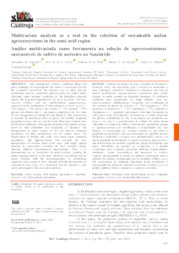Multivariate analysis as a tool in the selection of sustainable melon agroecosystems in the semi-arid region.
Multivariate analysis as a tool in the selection of sustainable melon agroecosystems in the semi-arid region.
Author(s): SALVIANO, A. M.; CASTRO, J. M. da C. e; MELO, S. B. de; MACEDO, M. V. de; OLIVEIRA, V. R.; GIONGO, V.
Summary: Soil management systems, including tillage and green manuring, are important for the control of nematodes and for the sustainable production. The objective was to select, through multivariate analysis, sustainable agroecosystems for yellow melon cultivated under irrigated conditions in the Brazilian semi-arid region. The long-term experiment is set up in Argissolo Vermelho- Amarelo (Ultisol) with six multifunctional agroecosystems, composed of the combination of three mixtures of cover crops (1 - 75% legumes + 25% grasses and oilseeds; 2 - 25% legumes + 75% grasses and oilseeds and 3 - spontaneous vegetation) and two types of soil management (no tillage-NT and tillage-T). The purpose was to evaluate the nutritional status of plants, soil fertility, nematode population in roots and soil, and the yield. Data were analyzed with multivariate techniques, allowing the grouping of the agroecosystems based on their similarities and complexity of functions. The incorporation of plant residues to the soil reduces nematode population, but their maintenance on the surface allows the improvement of fertility and yield, even under larger nematode populations. The agroecosystems that associate the non-incorporation of residues from cover crops with larger species diversity in composition constitute the most complex model, allowing different environmental functionalities. Thus, it is recommended not to incorporate the plant residues, planting the melon seedlings directly in the straw. However, considering that the results obtained with the non-incorporation of spontaneous vegetation were similar to those obtained with the incorporation of commercial cover crops, it is concluded that this practice is also viable and adapted to the semi-arid conditions.
Publication year: 2023
Types of publication: Journal article
Unit: Embrapa Semi-arid Region
Observation
Some of Embrapa's publications are published as ePub files. To read them, use or download one of the following free software options to your computer or mobile device. Android: Google Play Books; IOS: iBooks; Windows and Linux: Calibre.
Access other publications
Access the Agricultural Research Database (BDPA) to consult Embrapa's full library collection and records.
Visit Embrapa Bookstore to purchase books and other publications sold by Embrapa.

